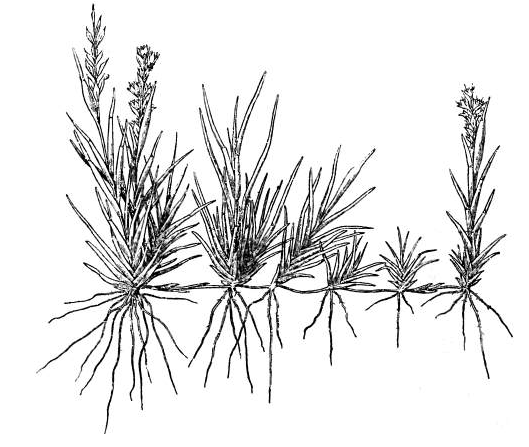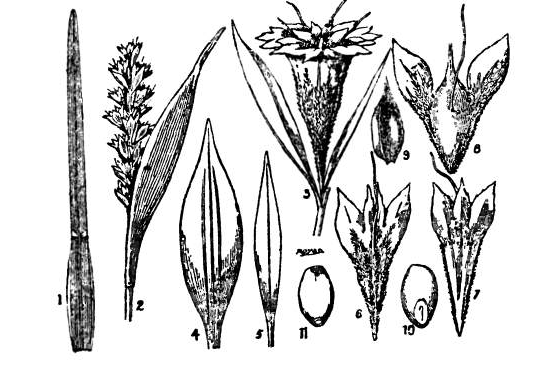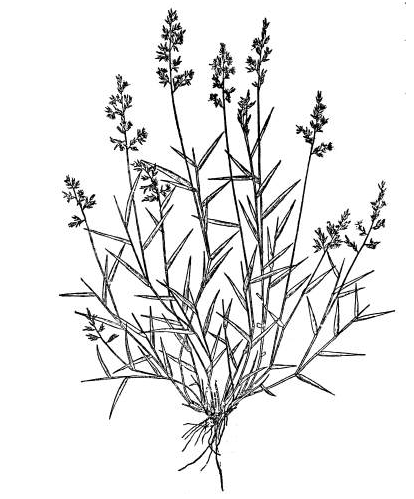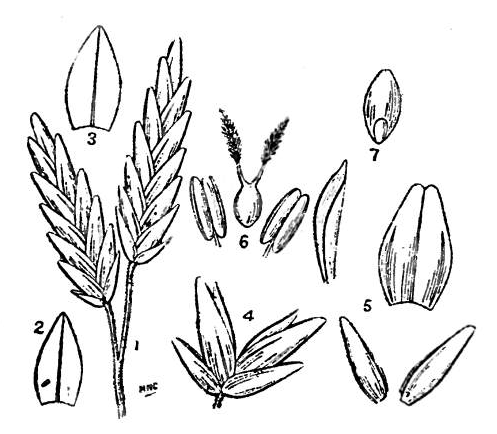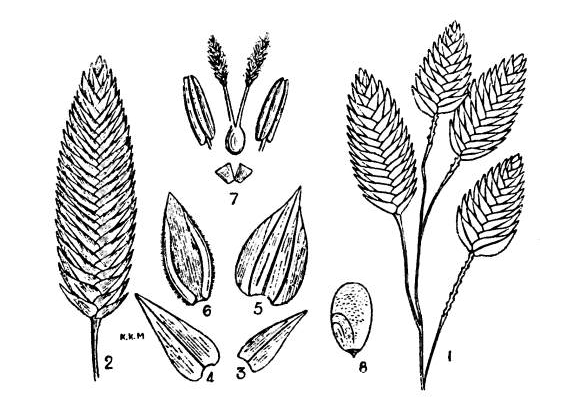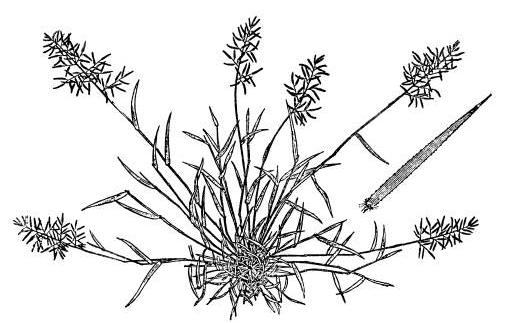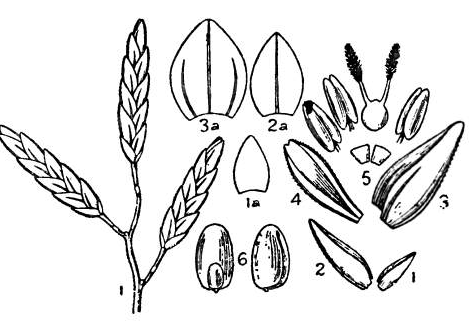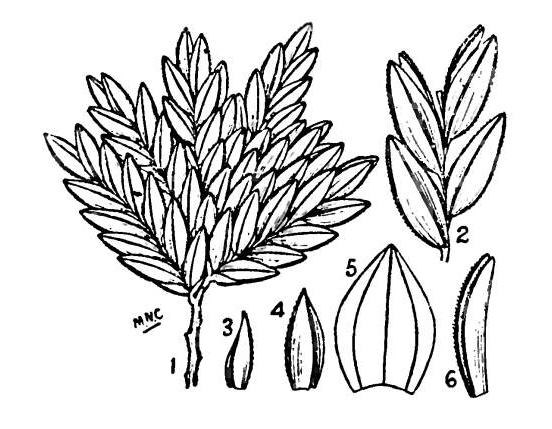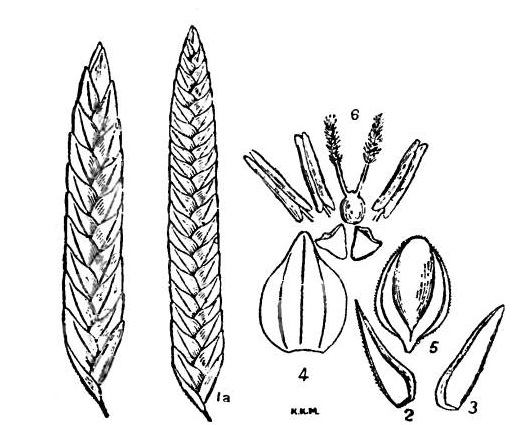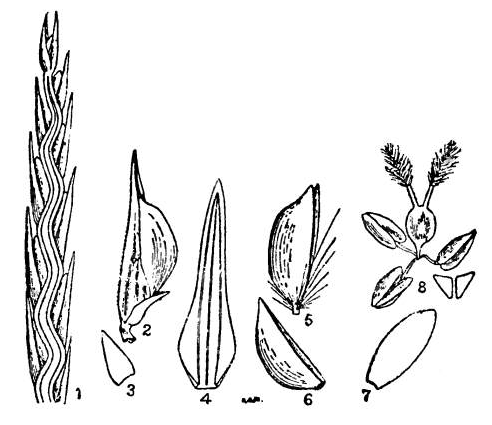A Handbook Of Some Common South Indian Grasses: 11-Festucaceæ And Hordeæ
This is an extract from |
Festucaceæ
Festucaceæ is of minor importance as it is not well represented in the South India. Only about half a dozen genera occur and most of them on the hills. The spikelets are usually 2- or more-flowered, pedicelled and in panicles, open or contracted. The rachilla is produced beyond the flowering glumes and articulate at the base just above the empty glumes. Inflorescence a raceme, spikelets 2- to 3-flowered, turbinate; glumes single-awned. 40. Pommereulla.
Inflorescence paniculate, spikelets few or many-flowered, glumes many-nerved and many-awned. 41. Pappophorum.
Inflorescence various, spikelets 2- to many-flowered, flowering glumes 1- to 3-nerved entire, empty glumes shorter than the lowest flowering glume, grain very minute. 42. Eragrostis.
Hordeæ
Hordeæ is also a minor tribe and is represented by only one genus in South India. The spikelets are one-or more-flowered, sessile, 1- or 2-seriate on the rachis, and somewhat sunk in cavities; the rachilla is jointed at the base and is produced beyond the flowering glumes, glumes awned or not.
Spikelets 1- to 3-flowered, first glume very minute or wanting, second as long as the hyaline, third spike compressed, solitary. 43. Oropetium.
40. Pommereulla, Linn. f.
This is a short, stout, creeping perennial grass. Spikelets are 2- to 3-flowered, distichously racemed, narrowly turbinate, villous. Glumes are 5 to 7 in a spikelet. The first two glumes are narrow, membranous, persistent, the first glume being 1-nerved and shorter than the second which is 3- to 5-nerved. The third and the fourth glumes embracing the fifth and the sixth are empty, flabelliform, 4-lobed, and dorsally shortly awned. The fifth, sixth and the seventh are cuneate, obovate and 3-lobed, palea ovate, acute, and pubescent. Lodicules are two and membranous. Stamens are two to three with small anthers. Grain is oblong, compressed and free.
Pommereulla Cornucopiæ, Linn. f.
This is a short, stout perennial grass with stems rooting at the nodes; branches are flat, short, densely leafy, 2 to 6 inches long.
The leaf-sheaths are smooth, equitant with thinly membranous margins. The ligule is a ciliated ridge.
The leaf-blade is flat, linear, distichous, coriaceous, rounded at the tip, margins sparsely ciliate, 1 to 2-1/2 inches long.
The inflorescence is a terminal raceme, 1/2 to 2 inches long, half hidden by the uppermost leaf-sheath, the peduncle is flattened and 1 to 2-1/2 inches long; rachis is also flattened with a tuft of long silky hairs at the base.
The spikelets are shortly pedicelled or sessile, dorsally compressed, cuneiform, about 1/3 inch, glistening, villous, not articulate at the base, 2- to 3-flowered, rachilla is narrowed downwards, resembling a callus and villous, jointed at the acute base above the empty glumes, and crowned with broad obconic empty awned glumes. The spikelets have usually seven, rarely eight glumes.
The first and the second glumes are narrow, membranous, glistening, empty and persistent and the others are coriaceous with membranous margins. The first glume is linear or linear-lanceolate, acuminate, 1-nerved, scaberulous along the nerve. The second glume is longer than the first, oblong-lanceolate, acuminate, narrowed towards the base, inserted much above the first glume and embracing the rachilla, 3-nerved, scaberulous along the mid-nerve at the base only.
The third and fourth glumes are half-amplexicaul, empty, epaleate, flabelliform, 4-lobed, 7-nerved, shortly awned at [Pg 287]the back, villous; the side lobes are acuminate or aristate and the central lobes are shortly awned. The fifth, sixth and seventh glumes are obovate-cuneate, 7- to 9-nerved, paleate, flower-bearing and 3-lobed, the side lobes are acuminate and the central lobe is bifid and dorsally awned; palea is ovate-acute, 2-nerved and ciliolate. The eighth glume, if present, is neuter and imperfect, 3-lobed and shortly awned. Lodicules are minute. Stamens are two or three with small anthers. Grain is oblong, compressed, reddish brown.
This grass generally grows in gravelly and somewhat alkaline soils. So far this has been noticed and collected in Chingleput and Nellore districts.
Distribution.—Mysore and the Carnatic, and Ceylon.
41. Pappophorum, Nees.
This is a perennial grass. Spikelets are contracted spiciform panicles, 1- to 3-flowered, rachilla is jointed at the base. There are 5 to 7 glumes in the spikelet. The first and the second glumes are membranous, keeled 3- to many-nerved, persistent. The third and the fourth glumes are much shorter (excluding the awns) than the first two, coriaceous, orbicular, concave, obscurely many-nerved, cleft into nine or more equal or alternately longer long-ciliate erect awns.
The fourth and the subsequent glumes are imperfect and they get gradually smaller and smaller, the last glume being represented only by a rudimentary glume with three awns. Lodicules are dolabriform and two. Stamens are three. Styles are free. Grain is obovoid or oblong, free.
Pappophorum elegans, Nees.
This grass is perennial with wiry roots. Stems are erect ascending from a swollen woody base, thinly hairy and rarely glabrous, pale green and sometimes with red blotches, wiry, varying in length from 1 to 3 feet.
The leaf-sheath is thinly pubescent, some hairs being minutely gland-tipped.
The leaf-blade is narrow, linear-lanceolate, sharply acuminate, covered both above and below with hairs, many of which being minutely gland-tipped, convolute when young. The ligule is a ridge of hairs. Nodes are pubescent.
The inflorescence is a panicle with short branches, 1 to 3 inches long, rachis is pubescent; peduncle is 2 to 4 inches long, pubescent. The spikelets are pale green, sometimes purple tinged and appearing white when mature, softly pubescent, about 1/4 inch long including the awn; the rachilla is produced and disarticulates above the two lower glumes.
There are 6 or 7 glumes in the spikelet. The first glume is lanceolate, acute, softly hairy, usually 9-nerved, or varying from 7 to 12 (some nerves do not reach the apex), about 1/4 inch long. The second glume is similar to the first but a little longer and both the glumes have broad hyaline margins.
The third glume is broadly orbicular, concave, sub-chartaceous, 9-nerved, densely villous and with a tuft of hairs at the base where it joins the rachilla, cleft into 9 awn-like lobes, bisexual and paleate; the awns are alternately long and short, subulate, plumose in the lower half and scabrid above, the palea is oblong-ovate, sub-chartaceous, with two pubescent keels, bifid at the apex, and with 3 purple anthers. The ovary is ovoid or ovoid-oblong, with two white stigmas. Lodicules are two, small cuneate or quadrate. Grain ovoid or ovoid-oblong. The fourth glume is similar to the third glume but smaller, paleate with rudimentary anthers and two fleshy lodicules.
The fifth, sixth and seventh glumes are imperfect and gradually decreasing in size, and with awns varying in number from 5 to 8, 3 to 5, and 1 to 3, respectively, minutely paleate or not.
This grass grows well in black cotton and rich loamy soils and is a hardy one. Cattle seem to eat this grass.
Distribution.—Fairly common in the plains in the Deccan districts and in the Coromandel coast districts.
42. Eragrostis, Beau
. These are slender, glabrous, annual or perennial grasses. Stems are usually erect or geniculately ascending, very rarely prostrate. Leaves are narrow. Inflorescences are open or contracted panicles, rarely spikes. Spikelets are usually strongly laterally compressed, 2, to many-flowered and not articulate at the base; rachilla is tough and persistent, jointed above the empty glumes and in some also between the flowering glumes, not produced beyond the last glume. Glumes are many, broad, obtuse, acute or mucronate, never awned, dorsally rounded and keeled; the first and the second glumes are much shorter than the spikelet, equal or unequal, empty, persistent or separately deciduous, 1-nerved or the second 3-nerved, usually membranous.
Flowering glumes are imbricating, at length deciduous from the rachilla, 3-nerved, all bisexual or the uppermost and rarely the lowest imperfect, ovate to lanceolate, membranous to chartaceous, usually glabrous, the lateral nerves short not reaching the mid nerve; palea are broad, membranous, deciduous with its glume or persistent on the rachilla with two ciliate smooth or scabrid keels. Stamens are three rarely two. Ovary is glabrous with two styles ending in plumose stigmas. Grain is minute, globose, obgloboid or obovoid, free in the glume and the palea.
KEY TO THE SPECIES
A. Spikelets panicled.
B. Rachilla of spikelets more or less jointed and breaking up from above downwards.
Panicle more or less contracted and margin of flowering glumes not ciliate.
Spikelets 1/20 to 1/6 inch long; grain obovoid; stamens 2; panicle narrow interrupted, 6 to 18 inches long 1. E. interrupta.
BB. Rachilla of spikelets tough, persistent; flowering glumes falling away from base upwards. C. Spikelets pedicellate.
Spikelets flat, ovate-elliptic or oblong, lateral nerves of flowering glumes very prominent and straight, almost percurrent; palea deciduous with their glumes 2. E. amabilis.[Pg 293]
Spikelets less compressed, linear or linear-oblong; lateral nerves less prominent; not fascicled, long pedicellate and divaricate when ripe.
Leaf margins without glands. Spikelets versatile, narrow, linear 1 inch or more long, branches of panicle solitary 3. E. tremula. Leaf margins glandular.
First glume 1-nerved and second glume 3-nerved 4. E. major.
First glume and second glume 1-nerved 5. E. Willdenoviana.
Spikelets small, 1/4 inch or less, branches of panicle whorled 6. E. pilosa.
CC. Spikelets sessile and jointed on the very short densely crowded branchlets of a tall, narrow raceme like panicle, deciduous, acute, much compressed, imbricate and secund 7. E. cynosuroides.
AA. Spikelets in a long terminal spike. Spikelets distichously spreading, secund, keels of palea winged 8. E. bifaria.
Eragrostis interrupta, Beauv.
(Var. Kœnigii, Stapf.)
This is a tall grass, annual or perennial, with erect stems 1 to 3 feet or more.
The leaf-sheath is glabrous and close. The ligule is a short, fimbriate membrane. Nodes are glabrous.
The leaf-blade is narrow, flat, acuminate, glabrous on both sides, 3 to 10 inches long.
The panicle is erect, narrow, contracted, with branches in pseudo-whorls and varying in length from 6 to 18 inches, branches are slender, filiform, two or more arising from the same level, 1 to 3 inches long.
The spikelets are small, pedicellate, smooth, usually 6 to 14-flowered, pale but often tinged with red, the rachilla is jointed between the flowering glumes, and breaks away from above downwards. The empty glumes are very small, subequal, ovate-oblong, hyaline, obtuse and 1-nerved. Floral glumes also are small but slightly longer than the empty ones, ovate-oblong, obtuse and paleate, palea is linear-oblong with smooth or scabrid keels. Stamens are two with small anthers. Grain is obovoid.
This grass is a very variable plant and has a few varieties. The one described above is Var. Kœnigii Stapf., and this is the one that occurs very widely. The other two varieties which occur very rarely are (1) diarrhena Stapf. and (2) tenuissima Stapf. The former is a tall plant with very narrow panicle and spikelets and the latter either tall or short and with a panicle bearing very slender divaricate branches. This grass usually occurs in clayey soils especially on the bunds and in the paddy fields.
Distribution.—Throughout India, Burma and Ceylon. Also in tropical Asia and Africa.
Eragrostis amabilis, W. & A.
This is an annual tufted grass with slender, glabrous, erect or geniculately ascending stems, 6 to 18 inches, leafy chiefly at the base.
The leaf-sheath is glabrous and smooth. The ligule is absent or very obscure.
The leaf-blade is lanceolate-linear or linear, narrowed from a broad subcordate base to an acute tip, smooth and flat.
The panicle is ovoid-oblong or oblong, open or contracted, sparingly branched; branches are filiform, solitary, ramifying from near the base; rachis and nodes are glabrous.
The spikelets are ovate-oblong or linear-oblong, pale or purplish 1/6 to 1/2 inch, up to 50-flowered, rachilla is tough with very short internodes. The glumes are very closely and distichously imbricating (and hence spikelets are pretty); the empty glumes are subequal, ovate-lanceolate, acute or cuspidately acuminate, 1-nerved, 1/25 to 1/16 inch long. Flowering glumes are broadly ovate or suborbicular, mucronulate, punctulate, with the lateral nerves equidistant from the margins and the median nerve, and produced far up towards the median nerve; palea is broad, shorter than its glume, deciduous with it, and with winged and scabrid keels. Stamens are three. Grain is obovoid-ellipsoid, smooth, laterally compressed, reddish-brown.
This grass is abundant in wet places on the hills and fairly common in the plains though not abundant.
Distribution.—Throughout India and Ceylon.
Eragrostis tremula, Hochst.
This is an elegant annual grass. Stems are tufted erect or sometimes geniculately ascending, branching freely, 6 inches to 3 feet.
The leaf-sheath is smooth, glabrous, shorter than the internodes, becoming purplish when dry. The ligule is a ridge of short hairs.
The leaf-blade is linear-lanceolate, tapering to a fine point, rigid, glabrous or sparsely hairy, but with prominent white hairs near the mouth of the sheath at the base, 1 to 10 inches long and 1/12 to 3/16 inch broad, the base is rounded and the margin eglandular and very finely serrate.
The inflorescence is a large, effuse, nodding, pyramidal or oblong panicle, much branched, the peduncle being as long as the rest of the plant; branches are slender, solitary, suberect, drooping, rather angled, scaberulous, 3 to 7 inches long with very fine capillary branchlets; all the axils of the branches and branchlets have long white hairs.
The spikelets are linear, narrowed upwards, glabrous, flattened pale green or purple tinged, few to 70-flowered; pedicels are slender and capillary, longer or shorter than the spikelets; rachilla is zigzag and glabrous. The first two glumes are subequal, ovate, acute, one-nerved, keel obscurely scaberulous, membranous. The third and the succeeding flowering glumes are ovate, obtuse, as long as the second glume or slightly longer, sub-chartaceous, glabrous, three-nerved; palea is shorter than the glume, curved obovate oblong and persistent on the rachilla. Stamens are three with small anthers. Style branches are two. Lodicules are minute. Grain is nearly globose, compressed on one side, obscurely rugulose.
This grass is not very widely distributed although it occurs in some parts of the Presidency. It is common on the West Coast in sandy places.
Distribution.—From the Punjab to Bengal and Burma and Southward to Carnatic. Also said to occur in Afghanistan and Tropical Africa.
Eragrostis major, Host.
This is an annual tufted grass. Stems are erect or geniculately ascending, usually short, leafy and branched below, glabrous and shining, 1/2 to 2 feet long.
The leaf-sheath is glabrous, striate, shorter than the internodes, keeled with tubercles or glands on the keel and also on some of the smaller nerves on the sides, and bearded with long white hairs externally at the mouth. The nodes are glabrous purple, shining and with a glandular ring below. The ligule is a ridge of long hairs.
The leaf-blade is linear-lanceolate or linear, tapering to a fine point, glabrous, flaccid, margins finely serrulate and glandular, base rounded, varying in length from 1/2 to 10 inches and in breadth 3/16 to 7/16 inch; the midrib is prominent and with a row of glands beneath and there are 3 to 5 lateral nerves on each side of the mid-nerve.
The panicle is ovate or ovate-oblong, on a short, smooth peduncle, usually open and stiff; branches are usually many, sub-solitary or fascicled, spreading or suberect, capillary, stiff, again branching from near the base and about 3 inches long; rachis is angular, with glands and tufts of sparse white hairs at the angles of branches and branchlets.
Spikelets are linear to ovate-oblong, compressed, pale or green, sometimes purple tinged at the base, few to 40-flowered and occasionally up to 70-flowers, 1/8 to 1 inch.
The empty glumes are subequal or the first is a little shorter, ovate, acute, membranous, keeled, and sometimes the keels with glands; the first glume is usually one-nerved (rarely obscurely one- to three-nerved) and the second glume is three-nerved.
The flowering glumes are broadly ovate, oblique, obtuse, sometimes with a minute mucro, sub-chartaceous, punctulate, strongly three-nerved, paleate, about 1/12 inch long; palea is shorter than the glume, curved, obovate-oblong, keels ciliolate and persistent. Stamens are three with very small pale yellow anthers. Stigmas are two and white. Lodicules are very small. Grain is globose reddish brown, minutely and obscurely lineolate.
This grass is a very common weed occurring in cultivated dry fields all over this Presidency.
Distribution.—Throughout India and Ceylon in the plains and low hills. Occurs also in tropical and sub-tropical parts of Asia and Africa.
Eragrostis Willdenoviana, Nees
. This is a tufted annual. Stems are leafy at the base, erect or geniculately ascending, slender but rigid, varying in length from 4 to 18 inches.
The leaf-sheath is smooth, cylindric, glabrous, outer margin ciliate; tufts of long hairs are present at the sides of the margin of the sheath, just outside close to the hyaline patch. The ligule is a fringe of short white hairs. The nodes are greenish or with a tinge of purple, glabrous and with a glandular ring below.
The leaf-blade is lanceolate-linear, pointed, flat, rigid, the margin is very minutely serrulate, glandular and occasionally also with fine long hairs; the upper surface is somewhat rough, the lower smooth and both with fine long scattered hairs or glabrous.
The inflorescence is a stiff open panicle, ovate to oblong, 2 to 4-1/2 inches long on a slender, terete, glabrous peduncle; the main rachis is angular, slender with glandular scars, a little below the attachment of the branches; the branches are capillary, grooved stiff and spreading with small glandular scars just above the node. The spikelets are elliptic-oblong to linear, 1/8 to 3/4 inch by about 1/20 inch, greenish or tinged with purple, few to about 25 (or sometimes even up to 42) glumed, pedicellate; pedicel is capillary, grooved and angular, with a glandular ring about the middle, spreading sometimes at right angles, rachilla is persistent.
Empty glumes are unequal. The first glume is hyaline very small, nerveless or one-nerved, subacute or subobtuse; the second glume is much longer than the first glume, ovate-oblong subacute, keeled, membranous and one-nerved. Flowering glumes vary from about 12 to 30 and in some well grown plants as many as 42, broadly ovate, obtuse or subacute, rigidly membranous, three-nerved (one median and two marginal) glabrous, keeled and keels are scaberulous near the apex; palea is oblong linear, a little curved, persistent, a little smaller than the glume, two-keeled; there are three stamens with small purplish anthers and two small lodicules.
The grain is oblong truncate at both ends, reddish brown, with a prominent groove on the dorsal side; embryo occupying nearly half the length of the grain.
This grass grows abundantly in somewhat rich soils all over the Presidency and cattle eat it. It grows quickly and bears a fair amount of foliage.
Distribution.—Madras Presidency in the plains; also occurs in Ceylon.
Eragrostis pilosa, Beauv.
This is a densely tufted annual grass. Stems are usually erect, slender and simple, flaccid, 3 inches to 3 feet.
The leaf-sheath is compressed, glabrous and bearded with long hairs close to the mouth. The ligule is a ridge of hairs.
The leaf-blade is short, narrow, finely acuminate, 1-1/2 to 4 inches.
The panicle is oblong to pyramidal, flaccid, open or contracted erect or inclined, 2 to 8 inches; rachis is hairy or glabrous; branches are very fine filiform or capillary, more or less whorled, lower six inches long; branchlets are still finer and capillary.
Spikelets are linear, grey tipped with purple, or often purplish, scattered, 1/8 to 1/5 by 1/30 to 1/20 inch, with pedicels shorter or longer than the spikelets. The empty glumes are hyaline, very unequal, nerveless or the second which is ovate-lanceolate and larger than the first faintly 1-nerved. The flowering glumes are ovate acute, paleate, 1/10 to 1/8 inch; palea is sub-persistent and keels of palea scaberulous. Stamens are three with small violet anthers. Grain is ellipsoid laterally pointed at the base.
This grass occurs in wet places or close to the margins of ponds, marshy situations all over the Presidency.
Distribution.—All over India and also in South Europe and most warm countries.
Eragrostis cynosuroides, Beauv.
This is a tall perennial grass freely branching from the base and with stout stolons covered with shining sheaths. The root-stock is stout and creeping. The stems are tufted, smooth, erect, with fascicles of leaves at the base 1 to 3 feet high.
The leaf-sheath is glabrous, slightly compressed, distinctly keeled, as broad or slightly broader than the blade at the mouth. Ligule is a line of short hairs.
The leaf-blade is linear, rigid, glabrous, acuminate with filiform tips, and finely serrulate margins, varying in length from 2 to 10 inches and the basal leaves sometimes reaching 20 inches.
The panicle is strict, erect, narrowly pyramidal, often interrupted, varying in length from 6 to 18 inches and breadth from 1/2 to 2 inches. Branches are many, short, crowded, densely clothed from the base with sessile, imbricating, much compressed deflexed spikelets.
The spikelets are secund, biseriate, shining, pale brown, 1/2 inch long, up to 30-flowered. The empty glumes are unequal, the second being the larger. The flowering glumes are coriaceous, ovate, acute as long as the second or slightly longer, paleate, palea is sub-coriaceous and shorter than the glume. Stamens are three. Grain is obliquely ovoid, laterally compressed.
This grass grows usually in moist sandy loams, sand dunes, and is very common on the Coromandel coast and in the Deccan Districts.
Distribution.—Throughout in the plains of India.
Eragrostis bifaria, Wight Ex Steud.
This is a densely tufted perennial grass. Stems are simple, erect, glabrous, somewhat compressed, 1 to 3 feet high, and the base clothed with the old remains of the leaf-sheaths.
The leaf-sheath is scaberulous, keeled. The ligule is a line of fine hairs.
The leaf-blade is wiry, narrow, linear, flexuous, rigid, acute, smooth, flat or complicate, keeled, 2 to 3 inches long and up to 1/6 inch wide.
The spikes are solitary, 10 to 12 inches long bearing spikelets unilaterally.
The spikelets are ovate or ovoid to oblong, much compressed, usually 15- to 20-flowered and up to 40 and then linear, 1/4 to 2/3 inch long, spreading, green or olive grey. The empty glumes are one-nerved and keeled. The first glume is longer than the second glume, very acute or acuminate. The second glume is smaller than the first, with stout rounded keel. The flowering glumes are as long or slightly shorter than the first glume, broadly ovate, sub-acuminate, with faint nerves and paleate; palea is shorter than its glume and with ciliate wings to the keel. Stamens are three. Grain is free.
This grass is very common in the plains in somewhat wet situations all over the Presidency.
Distribution.—Deccan Peninsula in India and also in Tropical Africa.
43. Oropetium, Trin.
A very small densely tufted erect annual. Leaves are filiform. The inflorescence is a simple slender curved spike. Spikelets are very minute, one-flowered, half immersed in the alternating distichous cavities of the rachis of the spike; rachilla is bearded. There are three glumes in the spikelet. The first glume is very minute, empty, hyaline and persistent. The second glume is linear-lanceolate, rigid, empty, persistent recurved when old, tip obtuse or emarginate. The third glume is shorter broader, hyaline, one-nerved, obtuse or truncate, palea is narrow with smooth keel. Lodicules are not found. Stamens are three. Grain is oblong terete and free.
Oropetium Thomæum, Trin.
This is a very small densely tufted annual grass, never exceeding 3 inches in height and with compressed slender, tough stems.
The leaf-sheath is compressed, membranous, short and open. The ligule is an erect lacerate membrane.
The leaf-blade is filiform, shorter or longer than the stem, erect or curved, coriaceous with the margins sparsely ciliate with long strict hairs, 1/2 to 1 inch long.
The spikes are solitary or fascicled curved on very short branches 1 to 1-1/2 inches long; rachis is green, undulating, tetragonous, with a broad central nerve on the flat faces.
The spikelets are very small, one-flowered, half immersed in the alternating distichous cavities of the rachis. There are three glumes in the spikelet. The first glume is very minute, hyaline and sunk in the hollow of the rachis. The second glume is the longest, linear-lanceolate, rigid, tip obtuse or emarginate, slightly convex with a broad thickened centre and recurved in fruit. The third glume is shorter than the second, hyaline, broader obtuse, semi-circular in profile, excessively membranous, with the callus bearded and paleate; palea is smaller than the glume. There are three stamens. Grain is oblong, terete, free.
This small grass is very common all over the Presidency in the plains in moist places.
Distribution.—Plains of India, Burma and Ceylon.
